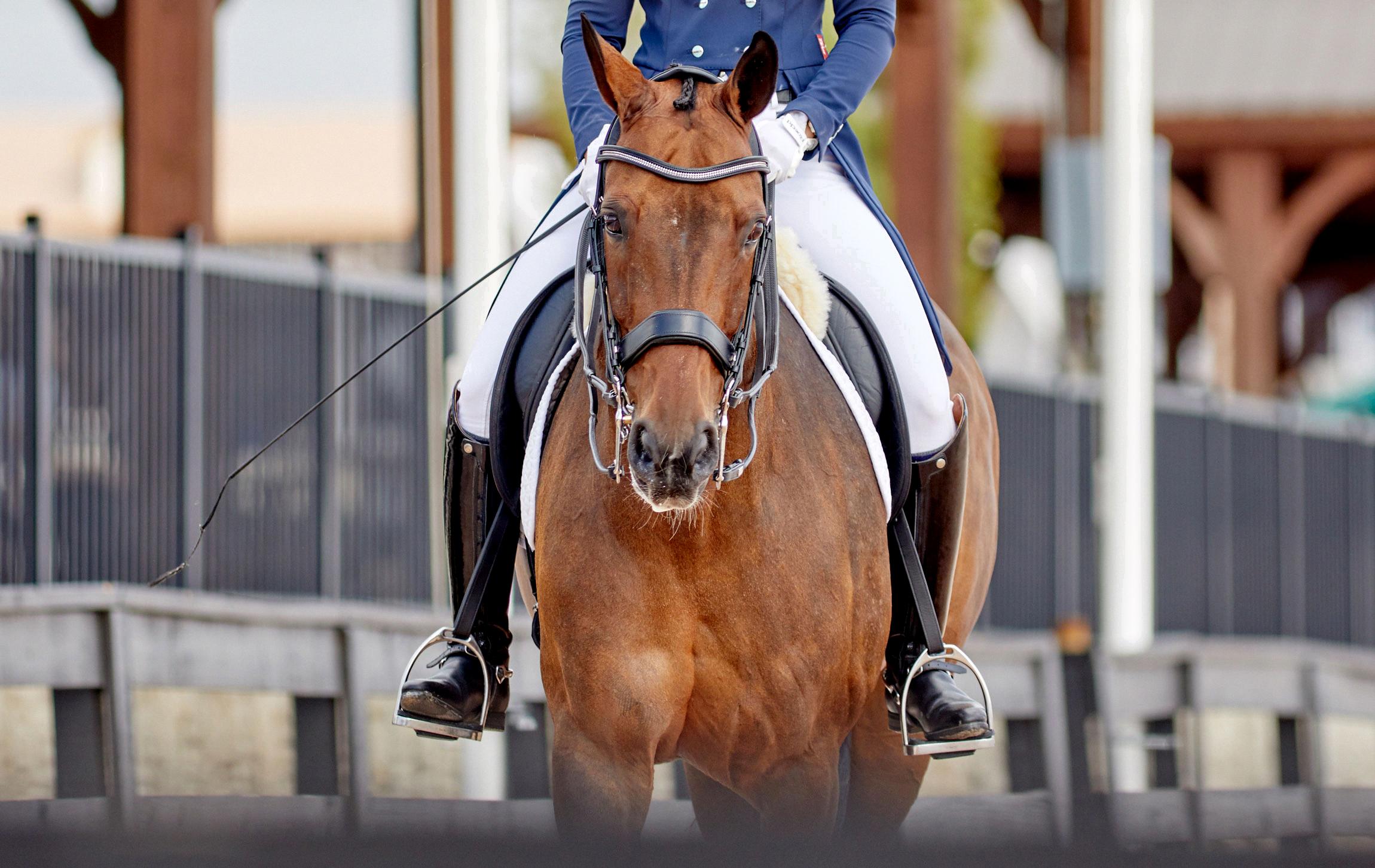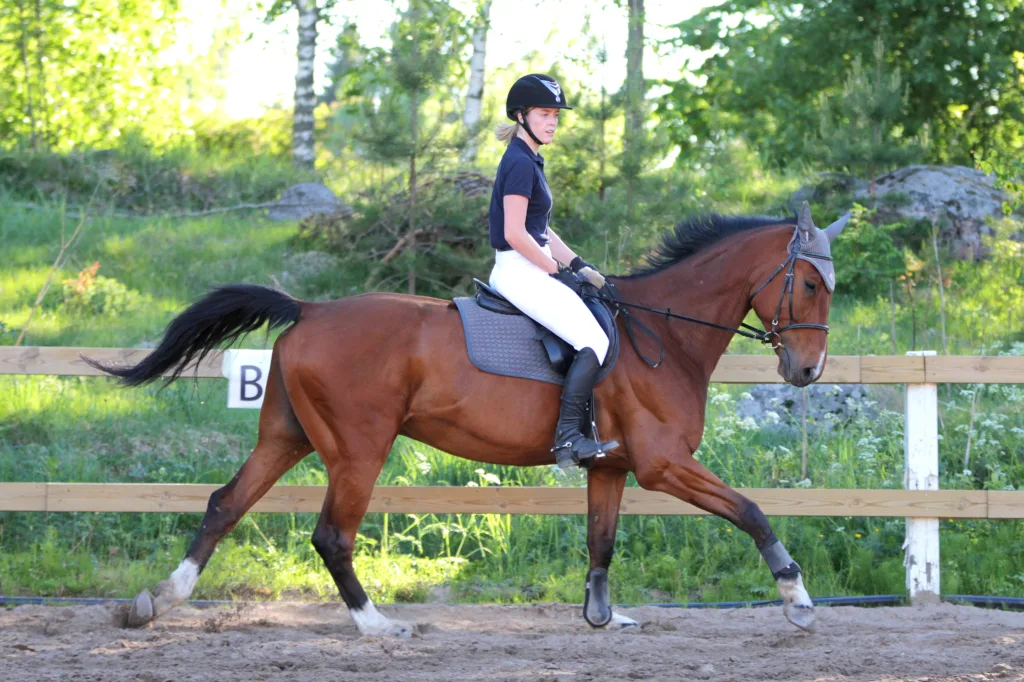Cantering is a common riding gait that comes aftr the trot. It is a three-beat gait that is faster than a trot, but slower than a gallop. The average speed of a canter is about 12-15 mph, making it a comfortable pace for both horse and rider.
As a beginner rider, you may find sitting the canter somewhat difficult. It can feel awkward at first to position your body in a way that allows you to move with the rhythm of your horse. The key to mastering the canter is to practice your balance and coordination in the saddle.
In canter, the rider uses his leg aids at the same time and in unison. However, it gets a bit more challenging than the trot because the legs lie in a different position on the horse’s belly, and they are used in a different rhythm than in the other gaits. The inner leg stays on the girth, and the outside leg goes behind the girth.
It’s important to note that the speed of a canter can vary depending on the horse’s breed, size, and level of training. Some horses may naturally have a faster or slower canter than others. Additionally, the terrain and riding conditions can also affect the speed of the canter.
The canter is a fun and enjoyable gait to ride. It is a great way to cover more ground and explore the outdoors at a comfortable pace. With practice and patience, riders can become confident and skilled at cantering, making it a highlight of their equestrian experience.
Comparing the Speed of Cantering and Galloping
When it comes to horse gaits, the canter and the gallop are two of the fastest. However, there is a notable difference between their speeds.
The canter is a three-beat gait and is generally slower than the gallop. It is oftn described as a smooth and rhythmic gait, with an average speed of around 12-15 mph. This gait is commonly used in horse riding competitions such as dressage or horsemanship.
On the other hand, the gallop is a four-beat gait and is much faster than the canter. It is often used in horse racing and is the fastest gait a horse can perform. The average speed of a gallop is around 25-35 mph, but racing horses can reach even higher speeds.
It’s worth noting that the speed of a horse can vary depending on factors such as breed, size, and training. Additionally, the terrain and the rider’s ability can also affect the speed of the horse.
To summarize, while both the canter and the gallop are fast, the gallop is generally faster than the canter, with an average speed of around 25-35 mph.

Source: fei.org
Average Speed of a Trot
The average speed for a trot is eight miles per hour. This is the speed at which horses travel when ridden by people, as they have a hard time maintaining faster speeds over long distances. It is important to note that the trot is a two-beat diagonal gait, meaning that the horse’s diagonal pairs of legs move together. This results in a smooth, rhythmic motion that is easy for riders to sit.
It shuld be noted that there are different variations of the trot, including the working trot, collected trot, and extended trot. The working trot is the most common and is used in most riding situations. The collected trot is slower and more controlled, while the extended trot is faster and covers more ground.
In comparison to other horse gaits, the trot is slower than the lope but faster than the walk. The lope, also known as a canter, is a three-beat gait that is faster than the trot and slower than the gallop. The gallop is the fastest gait, in which the horse moves all four legs together in a two-beat stride.
To summarize, the average speed for a trot is eight miles per hour, and it is a two-beat diagonal gait that is easy for riders to sit. There are variations of the trot, including the working trot, collected trot, and extended trot. The trot is slower than the lope but faster than the walk, and the gallop is the fastest gait.
The Difficulty of Cantering on a Horse
Cantering is one of the three gaits of a horse, alongside walking and trotting. It is a fun and exhilarating gait that riders of all levels enjoy. However, for beginners, cantering can be challenging to master. Here are some reasons why:
1. Finding the right rhythm: Cantering has a specific rhythm that is different from walking and trotting. It requires a coordinated effort between the rider and horse to find the right beat. It may take some practice to get used to the feel of cantering.
2. Balance: Cantering requires a lot of balance from the rider. You need to keep your body in the correct position while the horse moves forward. This can take some time to master, especally if you’re new to riding.
3. Fear: Cantering can be intimidating for new riders. The faster pace and higher energy level of the horse can make some riders nervous. This fear can make it difficult to relax and find the right rhythm.
To make cantering easier, here are some tips:
1. Practice: The more you practice cantering, the easier it will become. Try cantering in a controlled environment, such as an arena, with the help of an experienced instructor.
2. Focus on your position: Keep your legs long and your heels down. Sit up straight and keep your shoulders relaxed. This will help you maintain your balance while cantering.
3. Relax: Try to relax and let the horse do the work. Don’t tense up or hold on too tight to the reins. This will help you find the right rhythm and enjoy the ride.
Cantering on a horse can be difficult for beginners. It requires finding the right rhythm, balance, and overcoming fear. However, with practice and focus on your position, you can improve your cantering skills and enjoy this exhilarating gait.
Comparing the Difficulty of Canter and Trot
The canter gait can be more challenging for riders compared to the trot gait, as it requires a different coordination of leg aids. In the trot, the rider uses their leg aids at the same time and in unison, while in the canter, the legs lie in a different position on the horse’s belly and are used in a different rhythm. Specifically, the rider’s inner leg stays on the girth while the outside leg goes behind the girth. This can take some practice and coordination to get right.
However, it is important to note that the difficulty of each gait can vary depending on the rider’s skill level and the horse’s temperament and training. Some riders may find the trot more challenging due to its bouncier nature or difficulty maintaining the correct diagonal. Ultimately, both the trot and canter require practice and skill to master, and it is up to the individual rider to determine whih gait they find to be more challenging.
To summarize the points made above, some reasons why riders may find the canter gait harder than the trot gait include:
– Different coordination of leg aids
– Inner leg stays on the girth while outside leg goes behind the girth
– Can take practice and coordination to get right
It’s important to note that both gaits require practice and skill to master, and the difficulty can vary depending on the rider and horse.

Conclusion
Cantering is a fun and exciting gait that falls in between the trot and the gallop in terms of speed. With an average speed of 12-15 mph, it is a great way to cover ground on a horse while enjoying the ride. As a rider, it may take some time to get used to the rhythm and leg aids required for cantering, but with practice, it can become a comfortable and enjoyable gait. So, whether you are a beginner or an experienced rider, don’t be afraid to try cantering and experience the thrill of riding at a faster pace.
